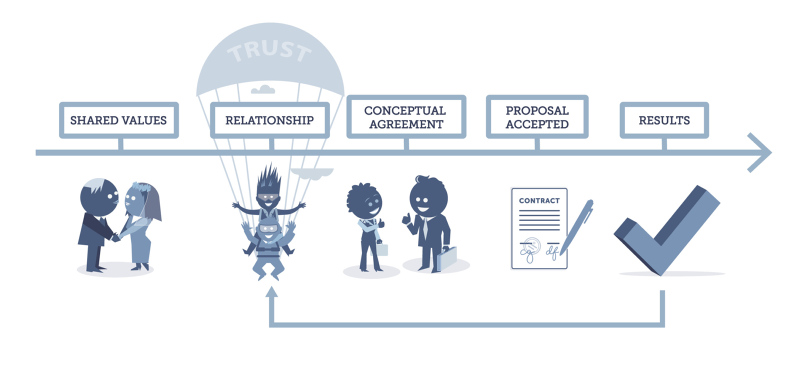Take your time and establish that you and your potential client share basic business values and that the project has a measurable outcome.

Selling management consulting is a relationship business. Without bilateral, trusting relationships, there will be no engagements. Thus, before we move to the details of a potential consulting engagement, there are some rituals that must be completed.
Working as a management consultant for over 15 years, I have come to the conclusion that I don’t sell anything. My profession is to help my clients improve their situations. When I leave the building, they must be measurably much better off than when I entered. That is the only way that I can demonstrate genuine value. Being a nice and helpful guy just doesn’t work for me. I need to see real and measurable change.
Making that change happen is not trivial and mechanical. As a management consultant, I am dealing with human beings. The changes that I can make are based on activities I do with the client and her staff. I may do some research on my own, but 80% of my consulting is based on working WITH the client and her staff. The final results are changes in the client’s behaviour and processes.
Ideal Client Profile
I accept that many business issues are the same across all industries and organizations. However, I have decided to focus my consulting business on helping information technology companies grow. Therefore I turn down all potential assignments outside this domain.
I have decided not to work with startups (with a few exceptions!). Although I have been intimately engaged in more than ten startups in my operational career, I am convinced that startups should avoid hiring management consultants. There is a world of difference between helping an established company increase their growth rate and helping a startup find a repeatable and scalable business model.
I have specialized in the first and not the second.
As 100% of my potential consulting engagements are inbound, I qualify them first against my Ideal Client Profile.
I finished the first post in this series with this illustration:

The credit for this process goes to Alan Weiss.
Before even thinking about the proposal there are three phases that I must complete with a potential client.
1. Shared Values
Shared values is the first step in building solid relationships. Stephen R. Covey’s seminal book “The 7 Habits of Highly Effective People” represents the very values that I subscribe to. When I am with a potential client that I don’t already know, I test if he or she shares the same values. If I sense that we are too far from each other, then I find a way out.
I assume we have all burned our fingers in the past. Did that teach us a lesson?
Take your time and establish that you and your potential client share basic business relationship values.
2. Relationship
Improving the performance capacity of my clients requires working closely with key people, and especially with the person having the P&L responsibility for the outcome. I must respect and trust my clients. Otherwise, I cannot deliver the value required.
Doing repeat business with people you know is much easier and less risky than engaging with someone new. It goes both ways.
Take your time and build a bilateral eye-to-eye relationship with your potential client.
3. Conceptual Agreement
Now we come to the specific engagement. This is where I failed utterly at the beginning of my management consulting career. I raced through this phase to get to the next, only to meet rejection.
Other posts in this series:
Banner image: Taken from the top of Salling in Aalborg, Northern Denmark. I posted this article from the café there.

Pingback: Slow down - it's not your business - Hans Peter Bech